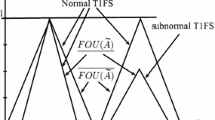Abstract
Fuzzy linear regression is an active area of research. In the literature, fuzziness is considered in outputs and/or in inputs. This paper focuses on both fuzzy inputs and fuzzy outputs. First, some approximations for multiplication of two triangular fuzzy numbers are introduced. Then, to evaluate the fuzzy linear regression, the best approximation is selected to minimize a suitable function via goal programming. An important feature of the proposed model is that it takes into account the centers of fuzzy data as well as their spreads. Moreover, it is flexible to deal with both symmetric and non-symmetric data. Furthermore, it can handle the crisp inputs and trapezoidal fuzzy outputs easily. To show the efficiency of the proposed model, some numerical examples are solved and compared with some earlier methods.







Similar content being viewed by others
References
Arabpour AR, Tata M (2008) Estimating the parameters of a fuzzy linear regression model. Iranian Journal of Fuzzy Systems 5(2):1–19
Bazaraa MS, Jarvis JJ, Sherali HD (2005) Linear Programming and Network Flows. Wiley, New York
Celmins A (1987) Least squares model fitting to fuzzy vector data. Fuzzy Sets and Systems 22:245–269
Chen YS (2001) Outliers detection and confidence interval modification in fuzzy regression. Fuzzy Sets and Systems 119:259–272
Choi SH, Buckley JJ (2008) Fuzzy regression using least absolute deviation estimators. Soft Computing 12(3):257–263
Choi SH, Kim HK, Park KO (2000) Nonlinear regression quantiles estimation. Journal of the Korean Statistical Society 29:187–199
Diamond P (1987) Least squares fitting of several fuzzy variables. In: Preprints of second IFSA congress, Tokyo, July 20–25, 1987
Diamond P (1988) Fuzzy least squares. Inf Sci 46:141–157
Dubois D (1987) Linear programming with fuzzy data. In: Bezdek JC (ed) Analysis of fuzzy information, vol 3. CRC Press, pp 241–263
Dubois D, Prade H (1978) Operations on fuzzy numbers. Int J Syst Sci 9:613–626
Dubois D, Prade H (1980) Fuzzy sets and systems: theory and applications. Academic Press, New York
Dubois D, Prade H (1983) Ranking fuzzy numbers in setting of possibility theory. Inf Sci 30:183–224
Hassanpour H, Maleki HR, Yaghoobi MA (2009a) A goal programming approach to fuzzy linear regression with non-fuzzy input and fuzzy output data. Asia-Pacific J Oper Res 26(5):1–18
Hassanpour H, Maleki HR, Yaghoobi MA (2009b) A note on evaluation of fuzzy linear regression models by comparing membership functions. Iran J Fuzzy Syst 6(2):1–6
Hassanpour H, Maleki HR, Yaghoobi MA (2010) Fuzzy linear regression model with crisp coefficients: a goal programming approach. Iran J Fuzzy Syst 7(2):19–39
Hojati M, Bector CR, Smimou K (2005) A simple method for copmutation of fuzzy linear regression. Eur J Oper Res 166:172–184
Hung WL, Yang MS (2006) An omission approach for detecting outliers in fuzzy regression models. Fuzzy Sets Syst 157:3109–3122
Kao C, Chyu CL (2002) A fuzzy linear regression model with better explanatory power. Fuzzy Sets Syst 126:401–409
Kao C, Chyu CL (2003) Least-squares estimates in fuzzy regression analysis. Eur J Oper Res 148:426–435
Kim B, Bishu RR (1998) Evaluation of fuzzy linear regression models by comparing membership functions. Fuzzy Sets Syst 100:343–352
Koenker R, Bassett G (1978) Regression quantiles. Econometrica 46:33–50
Ma M, Friedman M, Kandel A (1997) General fuzzy least-squares. Fuzzy Sets Syst 88:107–118
Modarres M, Nasrabadi E, Nasrabadi MM (2004) Fuzzy linear regression analysis from the point of view risk. Int J Uncertain Fuzziness Knowl-Based Syst 12(5):635–649
Modarres M, Nasrabadi E, Nasrabadi MM (2005) Fuzzy linear regression models with least square errors. Appl Math Comput 163:977–989
Nasrabadi MM, Nasrabadi E (2004) A mathematical-programming approach to fuzzy linear regression analysis. Appl Math Comput 155:873–881
Nguyen HT, Walker EA (2005) A first course in fuzzy logic. 3rd edn. Chapman & Hall, New York
Özelkan EC, Duckstein L (2000) Multi-objective fuzzy regression: a general framework. Comput Oper Res 27:635–652
Peters G (1994) Fuzzy linear regression with fuzzy intervals. Fuzzy Sets Syst 63:45–55
Redden DT, Woodall WH (1994) Properties of certain fuzzy linear regression models. Fuzzy Sets Syst 64:361–375
Sakawa M (1993) Fuzzy sets and interactive multiobjective optimization. Plenum, New York
Sakawa M, Yano H (1992) Multiobjective fuzzy linear regression analysis for fuzzy input–output data. Fuzzy Sets Syst 47:173–181
Savic DA, Pedrycz W (1991) Evaluation of fuzzy linear regression models. Fuzzy Sets Syst 39:51–63
Tanaka H (1987) Fuzzy data analysis by possibilistic linear models. Fuzzy Sets Syst 24:363–375
Tanaka H, Uejima S, Asai K (1982) Linear regression analysis with fuzzy model. IEEE Trans Syst Man Cybern 12:903–907
Wünsche A, Näther W (2002) Least-squares fuzzy regression with fuzzy random variables. Fuzzy Sets Syst 130:43–50
Yang MS, Lin TS (2002) Fuzzy least squares linear regression analysis for fuzzy input–output data. Fuzzy Sets Syst 126:389–399
Zadeh LA (1978) Fuzzy sets as a basis for a theory of possibility. Fuzzy Sets Syst 1:3–28
Acknowledgments
The authors would like to express their gratitude to the two anonymous referees for their comments and suggestions on the first version of this paper. Also, partial support by the Fuzzy Systems and Applications Center of Excellence at Shahid Bahonar University of Kerman is gratefully acknowledged.
Author information
Authors and Affiliations
Corresponding author
Rights and permissions
About this article
Cite this article
Hassanpour, H., Maleki, H.R. & Yaghoobi, M.A. A goal programming approach to fuzzy linear regression with fuzzy input–output data. Soft Comput 15, 1569–1580 (2011). https://doi.org/10.1007/s00500-010-0688-6
Published:
Issue Date:
DOI: https://doi.org/10.1007/s00500-010-0688-6




